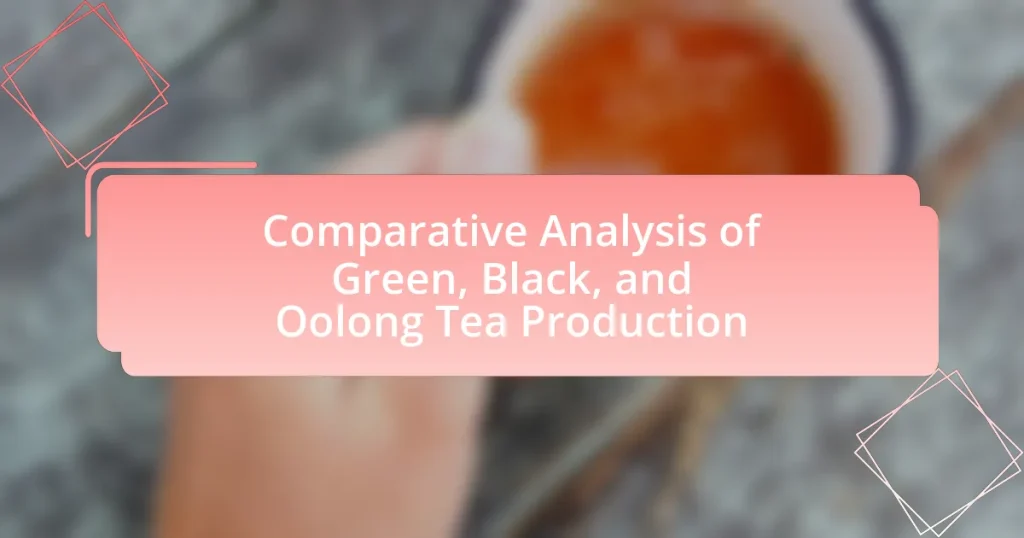The article provides a comparative analysis of green, black, and oolong tea production, highlighting the distinct processing methods and characteristics that influence their flavor profiles and health benefits. It details the production processes for each tea type, including key steps such as oxidation levels and processing techniques, and discusses the impact of these methods on flavor, aroma, and health benefits. Additionally, the article examines environmental impacts, economic aspects, market demands, and quality control measures associated with tea production, while also addressing innovations and sustainable practices shaping the future of the industry.

What is the Comparative Analysis of Green, Black, and Oolong Tea Production?
The comparative analysis of green, black, and oolong tea production reveals distinct processing methods and characteristics that influence their flavor profiles and health benefits. Green tea undergoes minimal oxidation, preserving its green color and fresh flavor, while black tea is fully oxidized, resulting in a darker color and stronger taste. Oolong tea is partially oxidized, placing it between green and black tea in terms of flavor and color. According to the Food and Agriculture Organization, global tea production in 2020 was approximately 6 million metric tons, with black tea accounting for about 70% of this total, green tea around 20%, and oolong tea making up the remaining 10%. This data highlights the dominance of black tea in the market, while also illustrating the unique niche that green and oolong teas occupy within the tea industry.
How do the production processes of green, black, and oolong tea differ?
The production processes of green, black, and oolong tea differ primarily in their oxidation levels and processing techniques. Green tea undergoes minimal oxidation, with leaves being quickly steamed or pan-fired to preserve their green color and fresh flavor. Black tea, in contrast, is fully oxidized, which involves withering, rolling, and allowing the leaves to oxidize before drying, resulting in a darker color and stronger flavor. Oolong tea is partially oxidized, falling between green and black tea; it is withered, partially rolled, and then allowed to oxidize to a specific degree before being heated to stop the process, creating a complex flavor profile. These distinct methods of oxidation and processing directly influence the taste, aroma, and appearance of each tea type.
What are the key steps in the production of green tea?
The key steps in the production of green tea include plucking, withering, steaming or pan-firing, rolling, and drying. Plucking involves harvesting young tea leaves, which are then withered to reduce moisture content. The steaming or pan-firing process quickly halts oxidation, preserving the green color and fresh flavor. Rolling shapes the leaves and further breaks down cell walls, enhancing flavor extraction. Finally, drying removes remaining moisture, ensuring the tea is shelf-stable. Each step is crucial for maintaining the unique characteristics of green tea, differentiating it from black and oolong teas, which undergo oxidation.
What are the key steps in the production of black tea?
The key steps in the production of black tea are withering, rolling, oxidation, and drying. During withering, freshly plucked tea leaves lose moisture, making them pliable for rolling. The rolling process breaks the leaf cells, releasing enzymes that facilitate oxidation. Oxidation is a crucial step where the leaves turn dark and develop flavor; this can take several hours. Finally, drying halts oxidation and preserves the tea, ensuring it is shelf-stable. Each of these steps is essential for producing the distinct flavor and characteristics of black tea.
What are the key steps in the production of oolong tea?
The key steps in the production of oolong tea include withering, bruising, oxidation, fixation, rolling, and drying. Initially, freshly harvested tea leaves undergo withering to reduce moisture content, which typically lasts several hours. Following this, the leaves are bruised to initiate oxidation, a crucial step that develops the tea’s flavor and aroma. The oxidation process is carefully monitored and can vary in duration, influencing the final product’s characteristics. After achieving the desired oxidation level, the leaves are subjected to fixation, usually through pan-firing or steaming, to halt oxidation. Subsequently, the leaves are rolled to shape them and enhance flavor release. Finally, the drying process removes any remaining moisture, ensuring the tea is shelf-stable. Each of these steps is essential in defining the unique qualities of oolong tea, which is known for its complex flavor profile and aromatic characteristics.
Why is it important to compare these types of tea production?
Comparing different types of tea production, such as green, black, and oolong tea, is important because it reveals distinct processing methods that influence flavor, health benefits, and market value. Each type undergoes unique steps; for instance, green tea is minimally oxidized, preserving its natural antioxidants, while black tea is fully oxidized, resulting in a stronger flavor profile. Understanding these differences allows consumers and producers to make informed choices regarding quality, health impacts, and economic factors, as evidenced by studies showing that green tea can contain up to 30% more catechins than black tea, highlighting its potential health advantages.
What impact does tea production have on flavor profiles?
Tea production significantly influences flavor profiles through factors such as oxidation, processing methods, and terroir. For instance, black tea undergoes full oxidation, resulting in robust, malty flavors, while green tea is minimally processed, preserving its fresh, grassy notes. Oolong tea, which is partially oxidized, offers a complex flavor spectrum that can range from floral to toasty, depending on the specific production techniques used. The terroir, or the environmental conditions where the tea is grown, also plays a crucial role; for example, teas from high-altitude regions often exhibit unique flavor characteristics due to the cooler climate and soil composition. These production variables collectively shape the distinct taste profiles of each tea type, confirming that the methods and conditions of tea production are integral to the final flavor experience.
How does production affect the health benefits of each tea type?
Production significantly affects the health benefits of green, black, and oolong tea types due to variations in processing methods and oxidation levels. Green tea, minimally processed and unoxidized, retains high levels of catechins, which are linked to antioxidant properties and cardiovascular health. In contrast, black tea undergoes full oxidation, resulting in higher theaflavins and thearubigins, compounds associated with improved cholesterol levels and gut health. Oolong tea, partially oxidized, offers a balance of both catechins and theaflavins, contributing to weight management and metabolic health. Studies indicate that these differences in production directly influence the bioactive compounds present in each tea type, thereby affecting their respective health benefits.
What are the environmental impacts of producing green, black, and oolong tea?
The environmental impacts of producing green, black, and oolong tea include deforestation, water usage, and pesticide application. Tea cultivation often leads to deforestation, particularly in regions where land is cleared for plantations, which disrupts local ecosystems and biodiversity. For instance, in countries like India and Sri Lanka, significant areas of forest have been converted to tea plantations, resulting in habitat loss for various species.
Water usage is another critical impact, as tea plants require substantial amounts of water, leading to depletion of local water resources. Research indicates that tea cultivation can consume up to 1,500 liters of water per kilogram of tea produced, which can strain local water supplies, especially in arid regions.
Additionally, the application of pesticides and fertilizers in tea production can lead to soil degradation and water pollution. Studies have shown that the runoff from tea plantations can contaminate nearby water bodies, affecting aquatic life and local communities.
Overall, while green, black, and oolong tea production provides economic benefits, it also poses significant environmental challenges that need to be addressed for sustainable cultivation practices.
How does the cultivation process differ in terms of sustainability?
The cultivation process of green, black, and oolong tea differs in terms of sustainability primarily due to their agricultural practices and resource management. Green tea cultivation often emphasizes minimal chemical use and promotes organic farming methods, which enhance soil health and biodiversity. In contrast, black tea production frequently relies on synthetic fertilizers and pesticides, leading to potential soil degradation and water pollution. Oolong tea cultivation can vary widely; some producers adopt sustainable practices similar to green tea, while others may not, depending on regional farming traditions. Research indicates that organic tea farming can reduce environmental impact by up to 30% compared to conventional methods, highlighting the importance of cultivation practices in sustainability.
What are the carbon footprints associated with each type of tea production?
The carbon footprints associated with green, black, and oolong tea production vary significantly due to differences in processing methods. Green tea production typically has a lower carbon footprint, averaging around 1.5 kg CO2 equivalent per kilogram of tea, as it undergoes minimal processing. Black tea production, which involves withering, rolling, fermenting, and drying, has a higher carbon footprint, averaging about 2.5 kg CO2 equivalent per kilogram. Oolong tea, which is partially fermented and requires more processing than green tea but less than black tea, has a carbon footprint of approximately 2.0 kg CO2 equivalent per kilogram. These figures highlight the impact of processing intensity on the overall carbon emissions associated with each type of tea.

What are the economic aspects of tea production?
The economic aspects of tea production include its contribution to employment, export revenue, and agricultural sustainability. Tea production employs millions globally, particularly in countries like China, India, and Kenya, where it serves as a primary source of income for rural communities. In 2021, the global tea market was valued at approximately $200 billion, with significant export revenues generated by countries such as India, which exported around $1.2 billion worth of tea in the same year. Additionally, tea cultivation promotes sustainable agricultural practices, as it often coexists with other crops, enhancing biodiversity and soil health. These economic factors underscore the importance of tea production in both local and global economies.
How do market demands influence the production of green, black, and oolong tea?
Market demands significantly influence the production of green, black, and oolong tea by dictating the types of tea cultivated, the methods of processing, and the volume of production. For instance, the rising global preference for green tea, attributed to its perceived health benefits, has led producers to allocate more land and resources to its cultivation, resulting in a 20% increase in green tea production from 2010 to 2020, according to the Food and Agriculture Organization. Conversely, black tea remains popular in traditional markets, prompting producers to maintain or increase its output to meet consistent demand. Oolong tea, while niche, has seen a resurgence in interest, particularly in Western markets, leading to targeted production strategies that cater to specialty tea consumers. Thus, market demands directly shape the agricultural and economic strategies of tea producers, influencing what types of tea are prioritized and how they are marketed.
What are the pricing trends for each type of tea?
The pricing trends for green, black, and oolong tea show distinct patterns influenced by factors such as production methods, demand, and market fluctuations. Green tea typically maintains a lower price point, averaging around $10 to $30 per kilogram, due to its widespread production and lower processing costs. Black tea prices range from $15 to $50 per kilogram, reflecting its popularity and the complexity of its production process. Oolong tea, known for its unique processing and flavor profile, commands higher prices, often between $30 and $100 per kilogram, driven by limited production and increasing demand in specialty markets. These trends are supported by market reports indicating that premium teas, particularly oolong, have seen a rise in consumer interest, leading to higher prices in recent years.
How do consumer preferences shape production practices?
Consumer preferences significantly shape production practices by driving demand for specific types of tea, such as green, black, and oolong. For instance, the increasing consumer interest in health benefits has led producers to focus on organic and minimally processed teas, which are perceived as healthier options. According to a report by the Tea Association of the USA, the demand for green tea has surged, prompting producers to adapt their cultivation and processing methods to meet this preference. Additionally, consumer preferences for sustainability have influenced production practices, leading to the adoption of eco-friendly farming techniques and certifications, such as Rainforest Alliance or Fair Trade, which appeal to environmentally conscious buyers. This alignment of production practices with consumer preferences ensures that producers remain competitive in the market.
What role do geographical factors play in tea production?
Geographical factors significantly influence tea production by determining climate, soil type, and elevation, which are critical for the growth of tea plants. Regions with specific climatic conditions, such as consistent rainfall and moderate temperatures, are ideal for cultivating tea, as seen in countries like China, India, and Sri Lanka. For instance, the Darjeeling region in India, located at high elevations, produces distinct flavors due to its unique climatic conditions and soil composition. Additionally, the terroir, or the environmental factors affecting a crop’s phenotype, plays a crucial role in the flavor profiles of green, black, and oolong teas, as variations in altitude and latitude can lead to differences in chemical composition and taste.
Which regions are known for producing green tea, and why?
Japan and China are the primary regions known for producing green tea due to their favorable climates and traditional cultivation methods. Japan, particularly in areas like Uji and Shizuoka, benefits from a temperate climate and rich volcanic soil, which enhance the flavor and quality of its green tea varieties, such as Sencha and Matcha. China, with regions like Zhejiang and Fujian, has a long history of tea cultivation, where diverse microclimates and centuries-old practices contribute to the production of renowned green teas like Longjing (Dragon Well) and Biluochun. These regions are characterized by specific environmental conditions, including adequate rainfall, sunlight, and altitude, which are essential for the growth of high-quality tea plants.
What geographical conditions are ideal for black tea production?
The ideal geographical conditions for black tea production include a warm climate with temperatures ranging from 20 to 30 degrees Celsius, high humidity levels, and well-drained, fertile soil. These conditions facilitate optimal growth and development of the Camellia sinensis plant, which is essential for producing high-quality black tea. Regions such as Assam in India and the Nilgiri hills in India exemplify these conditions, where the combination of altitude, rainfall (around 1500-3000 mm annually), and temperature supports robust tea cultivation.
How does the terroir affect oolong tea characteristics?
Terroir significantly influences the characteristics of oolong tea by affecting its flavor profile, aroma, and overall quality. The specific environmental factors such as soil composition, altitude, climate, and local agricultural practices contribute to the unique attributes of oolong tea from different regions. For instance, oolong tea grown in the high-altitude regions of Taiwan, like Alishan, tends to have a floral aroma and a creamy texture due to the cooler temperatures and misty conditions that slow down the growth of the tea leaves, allowing for more complex flavor development. In contrast, oolong tea from Fujian province in China, particularly Wuyi Rock tea, exhibits a mineral-rich flavor profile attributed to the rocky soil and specific climatic conditions of the region. These variations demonstrate how terroir directly impacts the sensory qualities of oolong tea, making it distinct from other tea types.

What are the quality control measures in tea production?
Quality control measures in tea production include strict monitoring of cultivation practices, processing techniques, and final product testing. These measures ensure that tea meets safety standards and quality specifications. For instance, regular inspections of tea gardens assess pesticide use and soil health, while processing facilities implement standardized methods to prevent contamination and maintain flavor profiles. Additionally, laboratories conduct chemical and microbiological analyses on finished products to verify compliance with health regulations and quality benchmarks, such as the presence of heavy metals or pesticide residues. These practices are essential for maintaining the integrity and safety of tea, which is a globally traded commodity.
How is quality assessed in green, black, and oolong tea production?
Quality in green, black, and oolong tea production is assessed through several key factors including leaf appearance, aroma, flavor, and infusion color. Leaf appearance is evaluated based on size, shape, and uniformity, with high-quality teas exhibiting whole, unbroken leaves. Aroma is assessed both in the dry leaf and the brewed tea, where fresh, complex scents indicate superior quality. Flavor is critically analyzed through tasting, with desirable characteristics such as sweetness, richness, and balance being indicators of high quality. Finally, infusion color is observed, as vibrant hues typically signify well-processed leaves. These assessment criteria are supported by industry standards and expert evaluations, ensuring consistency and quality across different tea types.
What standards are used to evaluate green tea quality?
The standards used to evaluate green tea quality include appearance, aroma, taste, and infusion characteristics. Appearance is assessed based on the leaf shape, color, and uniformity, while aroma evaluates the fragrance of the dry and brewed tea. Taste is judged on flavor, sweetness, bitterness, and aftertaste, and infusion characteristics consider the color and clarity of the brewed tea. These criteria are often supported by established grading systems, such as the Japanese Agricultural Standards (JAS) and the International Organization for Standardization (ISO) standards, which provide specific guidelines for quality assessment.
What standards are used to evaluate black tea quality?
The standards used to evaluate black tea quality include appearance, aroma, flavor, strength, and color. These criteria are assessed through sensory evaluation, where trained tasters analyze the tea’s dry leaves, brewed liquor, and infused leaves. For instance, the International Organization for Standardization (ISO) provides guidelines, such as ISO 3103, which outlines the method for brewing tea to ensure consistency in quality assessment. Additionally, the Tea Research Association emphasizes the importance of specific characteristics like briskness, body, and aftertaste in determining overall quality.
What standards are used to evaluate oolong tea quality?
Oolong tea quality is evaluated based on several standards, including appearance, aroma, taste, and infusion characteristics. The appearance is assessed by the shape and color of the leaves, which should be uniform and vibrant. Aroma evaluation focuses on the fragrance of the dry leaves and the brewed tea, with a preference for floral or fruity notes. Taste is judged on balance, complexity, and aftertaste, with high-quality oolong exhibiting a smooth and rich flavor profile. Finally, infusion characteristics involve the clarity and color of the brewed tea, which should be bright and clear. These standards are widely recognized in tea grading systems, such as those established by the International Tea Committee.
What innovations are shaping the future of tea production?
Innovations shaping the future of tea production include precision agriculture, automation, and sustainable practices. Precision agriculture utilizes data analytics and IoT technology to optimize growing conditions, leading to higher yields and better quality tea. Automation in harvesting and processing reduces labor costs and increases efficiency, with robotic systems being implemented in various tea estates. Sustainable practices, such as organic farming and water conservation techniques, are gaining traction as consumers demand environmentally friendly products. These innovations are supported by research indicating that precision agriculture can increase crop yields by up to 20%, while automation can reduce processing time by 30%.
How is technology improving the efficiency of tea production?
Technology is improving the efficiency of tea production through automation, precision agriculture, and data analytics. Automation in harvesting and processing reduces labor costs and increases speed, allowing for quicker turnaround times. Precision agriculture utilizes sensors and drones to monitor soil conditions and plant health, optimizing water and nutrient usage, which enhances yield quality and quantity. Data analytics enables producers to make informed decisions based on real-time data, improving overall management practices. For instance, a study by the International Tea Research Institute found that implementing these technologies can increase tea yield by up to 30%, demonstrating their significant impact on production efficiency.
What sustainable practices are being adopted in tea production?
Sustainable practices in tea production include organic farming, agroforestry, and water conservation techniques. Organic farming eliminates synthetic pesticides and fertilizers, promoting biodiversity and soil health. Agroforestry integrates tea cultivation with tree planting, enhancing ecosystem services and carbon sequestration. Water conservation techniques, such as rainwater harvesting and drip irrigation, reduce water usage and improve efficiency. These practices contribute to environmental sustainability and can enhance the quality of tea produced, as evidenced by studies showing that organic teas often have higher antioxidant levels compared to conventionally grown teas.
What are the best practices for producing high-quality tea?
The best practices for producing high-quality tea include selecting the right cultivar, ensuring optimal growing conditions, and implementing precise harvesting techniques. High-quality tea cultivars, such as Camellia sinensis var. sinensis for green tea and Camellia sinensis var. assamica for black tea, are essential for flavor and aroma. Optimal growing conditions involve well-drained soil, appropriate altitude, and adequate rainfall, which contribute to the plant’s health and flavor profile. Precise harvesting techniques, such as hand-picking young leaves and buds at the right time, significantly impact the tea’s quality, as the first flush of leaves typically yields the best flavor. Studies have shown that these practices lead to higher levels of desirable compounds like catechins and theanine, which enhance the tea’s taste and health benefits.
How can producers enhance the flavor and aroma of their tea?
Producers can enhance the flavor and aroma of their tea by optimizing cultivation practices, processing methods, and storage conditions. For instance, selecting high-quality tea cultivars and ensuring optimal growing conditions, such as soil quality and climate, can significantly impact the flavor profile. Additionally, the timing of harvest is crucial; picking leaves at the right stage of maturity can enhance the aromatic compounds.
Processing methods, including withering, oxidation, and drying, also play a vital role. For example, black tea undergoes full oxidation, which develops rich flavors, while green tea is minimally processed to retain fresh, grassy notes. Techniques such as steaming or pan-firing can further influence the final taste and aroma.
Finally, proper storage in airtight containers away from light and moisture preserves the tea’s volatile compounds, ensuring that the flavor and aroma remain intact over time. These practices are supported by research indicating that both agricultural and post-harvest techniques directly affect the sensory qualities of tea (Tea Research Institute, 2021).
What are common challenges faced in tea production, and how can they be overcome?
Common challenges faced in tea production include pests and diseases, climate variability, and labor shortages. Pests and diseases can be managed through integrated pest management (IPM) strategies, which combine biological control, cultural practices, and chemical treatments to minimize crop loss. Climate variability, such as changes in rainfall and temperature, can be addressed by selecting climate-resilient tea varieties and implementing water conservation techniques. Labor shortages can be mitigated by investing in mechanization and improving working conditions to attract and retain workers. These strategies have been shown to enhance productivity and sustainability in tea production.


